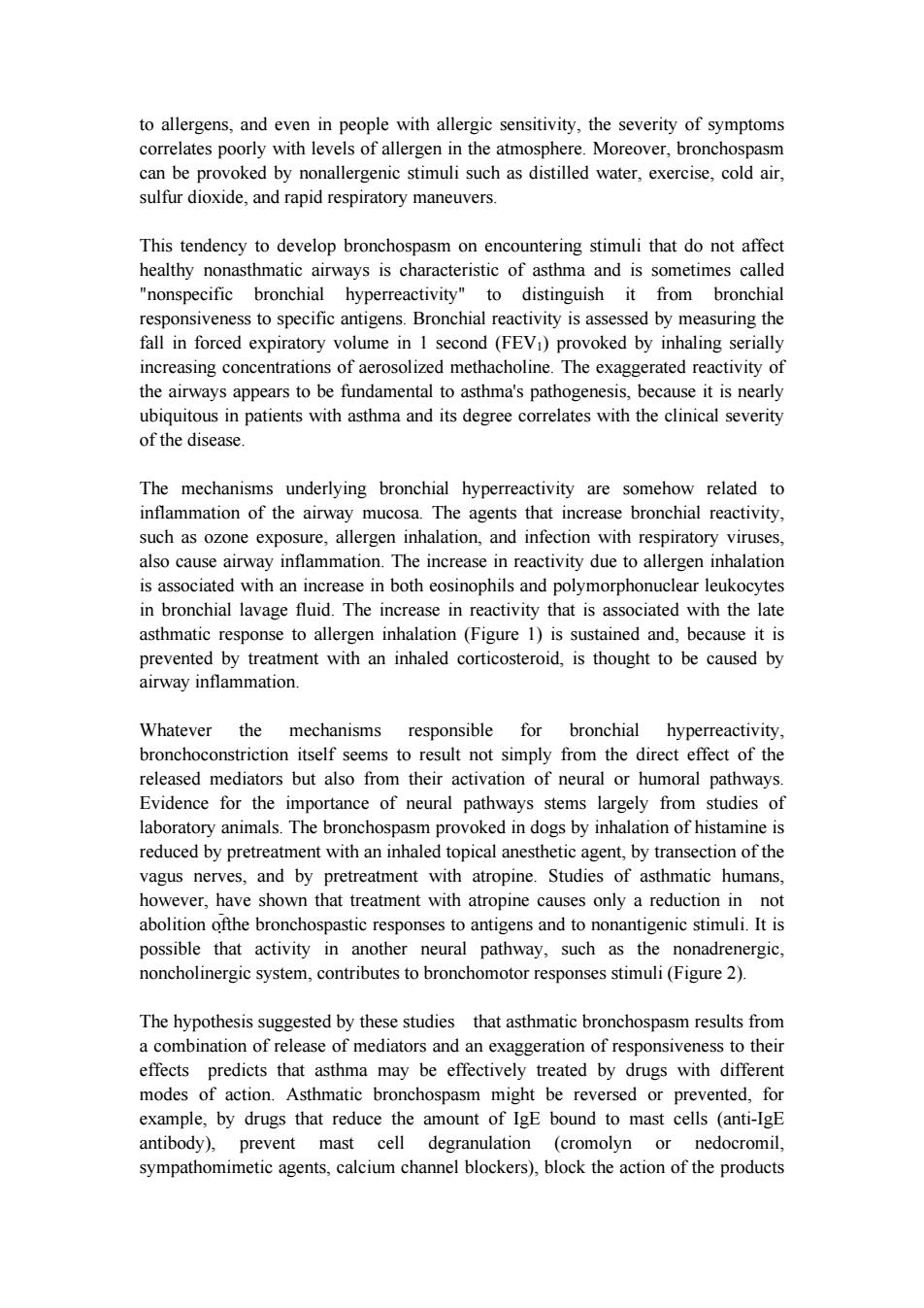正在加载图片...

to allergens,and even in people with allergic sensitivity,the severity of symptoms correlates poorly with levels of allergen in the atmosphere.Moreover,bronchospasm can be provoked by nonallergenic stimuli such as distilled water,exercise,cold air, sulfur dioxide,and rapid respiratory maneuvers. This tendency to develop bronchospasm on encountering stimuli that do not affect healthy nonasthmatic airways is characteristic of asthma and is sometimes called "nonspecific bronchial hyperreactivity"to distinguish it from bronchial responsiveness to specific antigens.Bronchial reactivity is assessed by measuring the fall in forced expiratory volume in 1 second(FEVI)provoked by inhaling serially increasing concentrations of aerosolized methacholine.The exaggerated reactivity of the airways appears to be fundamental to asthma's pathogenesis,because it is nearly ubiquitous in patients with asthma and its degree correlates with the clinical severity of the disease. The mechanisms underlying bronchial hyperreactivity are somehow related to inflammation of the airway mucosa.The agents that increase bronchial reactivity, such as ozone exposure,allergen inhalation,and infection with respiratory viruses, also cause airway inflammation.The increase in reactivity due to allergen inhalation is associated with an increase in both eosinophils and polymorphonuclear leukocytes in bronchial lavage fluid.The increase in reactivity that is associated with the late asthmatic response to allergen inhalation (Figure 1)is sustained and,because it is prevented by treatment with an inhaled corticosteroid,is thought to be caused by airway inflammation. Whatever the mechanisms responsible for bronchial hyperreactivity, bronchoconstriction itself seems to result not simply from the direct effect of the released mediators but also from their activation of neural or humoral pathways. Evidence for the importance of neural pathways stems largely from studies of laboratory animals.The bronchospasm provoked in dogs by inhalation of histamine is reduced by pretreatment with an inhaled topical anesthetic agent,by transection of the vagus nerves,and by pretreatment with atropine.Studies of asthmatic humans, however,have shown that treatment with atropine causes only a reduction in not abolition ofthe bronchospastic responses to antigens and to nonantigenic stimuli.It is possible that activity in another neural pathway,such as the nonadrenergic, noncholinergic system,contributes to bronchomotor responses stimuli(Figure 2). The hypothesis suggested by these studies that asthmatic bronchospasm results from a combination of release of mediators and an exaggeration of responsiveness to their effects predicts that asthma may be effectively treated by drugs with different modes of action.Asthmatic bronchospasm might be reversed or prevented,for example,by drugs that reduce the amount of IgE bound to mast cells (anti-IgE antibody),prevent mast cell degranulation (cromolyn or nedocromil, sympathomimetic agents,calcium channel blockers),block the action of the productsto allergens, and even in people with allergic sensitivity, the severity of symptoms correlates poorly with levels of allergen in the atmosphere. Moreover, bronchospasm can be provoked by nonallergenic stimuli such as distilled water, exercise, cold air, sulfur dioxide, and rapid respiratory maneuvers. This tendency to develop bronchospasm on encountering stimuli that do not affect healthy nonasthmatic airways is characteristic of asthma and is sometimes called "nonspecific bronchial hyperreactivity" to distinguish it from bronchial responsiveness to specific antigens. Bronchial reactivity is assessed by measuring the fall in forced expiratory volume in 1 second (FEV1) provoked by inhaling serially increasing concentrations of aerosolized methacholine. The exaggerated reactivity of the airways appears to be fundamental to asthma's pathogenesis, because it is nearly ubiquitous in patients with asthma and its degree correlates with the clinical severity of the disease. The mechanisms underlying bronchial hyperreactivity are somehow related to inflammation of the airway mucosa. The agents that increase bronchial reactivity, such as ozone exposure, allergen inhalation, and infection with respiratory viruses, also cause airway inflammation. The increase in reactivity due to allergen inhalation is associated with an increase in both eosinophils and polymorphonuclear leukocytes in bronchial lavage fluid. The increase in reactivity that is associated with the late asthmatic response to allergen inhalation (Figure 1) is sustained and, because it is prevented by treatment with an inhaled corticosteroid, is thought to be caused by airway inflammation. Whatever the mechanisms responsible for bronchial hyperreactivity, bronchoconstriction itself seems to result not simply from the direct effect of the released mediators but also from their activation of neural or humoral pathways. Evidence for the importance of neural pathways stems largely from studies of laboratory animals. The bronchospasm provoked in dogs by inhalation of histamine is reduced by pretreatment with an inhaled topical anesthetic agent, by transection of the vagus nerves, and by pretreatment with atropine. Studies of asthmatic humans, however, have shown that treatment with atropine causes only a reduction in not abolition ofthe bronchospastic responses to antigens and to nonantigenic stimuli. It is possible that activity in another neural pathway, such as the nonadrenergic, noncholinergic system, contributes to bronchomotor responses stimuli (Figure 2). The hypothesis suggested by these studies that asthmatic bronchospasm results from a combination of release of mediators and an exaggeration of responsiveness to their effects predicts that asthma may be effectively treated by drugs with different modes of action. Asthmatic bronchospasm might be reversed or prevented, for example, by drugs that reduce the amount of IgE bound to mast cells (anti-IgE antibody), prevent mast cell degranulation (cromolyn or nedocromil, sympathomimetic agents, calcium channel blockers), block the action of the products